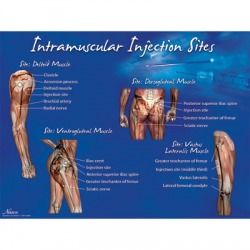Medication Administration
IM Medications

For this section, please read pages 872-877 in your Kozier and Erb text.
Intramuscular injections are injections into certain muscles, allowing for faster onset of action than with the subcutaneous route (Taylor, Lillis, Le Mone, & Lynn, 2008). Medications such as vaccines, hormones, and antibiotics are administered intramuscularly (Taylor, Lillis, Le Mone, & Lynn, 2008).
An adult can typically safely tolerate up to 3 ml of medication in the gluteal muscle (Berman, Snyder, Kozier & Erb, 2008). However, if a muscle is not well-developed, an adult may only be able to safely tolerate 1 to 2 ml (Berman et al., 2008). You can safely inject volumes of up to 1 ml in the deltoid muscle (Berman et al., 2008).
Equipment
Typical syringe size is 3 to 5 ml, depending on the amount of medication to be administered (Berman et al., 2008).
The size and length of the needle depends upon the muscle, medication, adipose tissue over the muscle, and age (Berman et al., 2008). For example, an obese patient may require a long needle, such as 2 inches, whereas a frail patient may require a short needle, such as a 1 inch (Taylor, Lillis, Le Mone, & Lynn, 2008).
Intramuscular Injection Needle Length
Site/Age Needle Length
Vastus lateralis 5/8” – 1”
Deltoid (children) 5/8” – 1 ¼”
Deltoid (adults) 1”- 1 ½”
Ventrogluteal (adults) 1 ½ “
(Nicoli & Hesby, 2002, as cited in Taylor, Lillis, Le Mone, & Lynn, 2008)
Appropriate gauge of the needle is also important. The gauge of the needle is determined by the type of medication being administered. Typically, medications in aqueous solutions and biologic agents will require a 20 to 25 gauge needle (Taylor et al., 2008). An 18 to 25 gauge needle should be used for oil based medications (Taylor et al., 2008).
Sites
Common sites for IM injections include the following:
1. The ventrogluteal muscle is the preferred site for adults and children over the age of 1 year because there are no large nerves or vessels, it is a large muscle, it is sealed by bone and contains less fat (Berman et al., 2008).
2. The vastus lateralis is usually well developed and thick in both children and adults, and is usually recommended for infants less than one year old (Berman et al., 2008).
3. The dorsogluteal site can be used for adults and children who have been walking for at least a year (Berman et al., 2008).
4. The deltoid site is typically chosen because of rapid absorption in the deltoid muscle, but only 1 ml or less of medication should be administered (Berman et al., 2008).
5. The rectus femoris site is used most often by persons administering their own injections since it is easily reached (Berman et al., 2008).
Intramuscular Site Selection
Age of Patient Recommended Injection Site
Infants Vastus lateralis
Toddlers and children Vastus lateralis or deltoid
Adults Ventrogluteal or deltoid
Type of Medication
Biologics (infants and young children Vastus lateralis
Biologics (older children and adults) Deltoid
Hepatitis B & Rabies Deltoid
Depot formulations Ventrogluteal
Medications known to be irritating, viscous, or oily solutions Ventrogluteal
(Nicoli & Hesby, 2002, as cited in Taylor et al., 2008)
Intramuscular injections are injections into certain muscles, allowing for faster onset of action than with the subcutaneous route (Taylor, Lillis, Le Mone, & Lynn, 2008). Medications such as vaccines, hormones, and antibiotics are administered intramuscularly (Taylor, Lillis, Le Mone, & Lynn, 2008).
An adult can typically safely tolerate up to 3 ml of medication in the gluteal muscle (Berman, Snyder, Kozier & Erb, 2008). However, if a muscle is not well-developed, an adult may only be able to safely tolerate 1 to 2 ml (Berman et al., 2008). You can safely inject volumes of up to 1 ml in the deltoid muscle (Berman et al., 2008).
Equipment
Typical syringe size is 3 to 5 ml, depending on the amount of medication to be administered (Berman et al., 2008).
The size and length of the needle depends upon the muscle, medication, adipose tissue over the muscle, and age (Berman et al., 2008). For example, an obese patient may require a long needle, such as 2 inches, whereas a frail patient may require a short needle, such as a 1 inch (Taylor, Lillis, Le Mone, & Lynn, 2008).
Intramuscular Injection Needle Length
Site/Age Needle Length
Vastus lateralis 5/8” – 1”
Deltoid (children) 5/8” – 1 ¼”
Deltoid (adults) 1”- 1 ½”
Ventrogluteal (adults) 1 ½ “
(Nicoli & Hesby, 2002, as cited in Taylor, Lillis, Le Mone, & Lynn, 2008)
Appropriate gauge of the needle is also important. The gauge of the needle is determined by the type of medication being administered. Typically, medications in aqueous solutions and biologic agents will require a 20 to 25 gauge needle (Taylor et al., 2008). An 18 to 25 gauge needle should be used for oil based medications (Taylor et al., 2008).
Sites
Common sites for IM injections include the following:
1. The ventrogluteal muscle is the preferred site for adults and children over the age of 1 year because there are no large nerves or vessels, it is a large muscle, it is sealed by bone and contains less fat (Berman et al., 2008).
2. The vastus lateralis is usually well developed and thick in both children and adults, and is usually recommended for infants less than one year old (Berman et al., 2008).
3. The dorsogluteal site can be used for adults and children who have been walking for at least a year (Berman et al., 2008).
4. The deltoid site is typically chosen because of rapid absorption in the deltoid muscle, but only 1 ml or less of medication should be administered (Berman et al., 2008).
5. The rectus femoris site is used most often by persons administering their own injections since it is easily reached (Berman et al., 2008).
Intramuscular Site Selection
Age of Patient Recommended Injection Site
Infants Vastus lateralis
Toddlers and children Vastus lateralis or deltoid
Adults Ventrogluteal or deltoid
Type of Medication
Biologics (infants and young children Vastus lateralis
Biologics (older children and adults) Deltoid
Hepatitis B & Rabies Deltoid
Depot formulations Ventrogluteal
Medications known to be irritating, viscous, or oily solutions Ventrogluteal
(Nicoli & Hesby, 2002, as cited in Taylor et al., 2008)
References
Berman, A., Snyder, S. J., Kozier, B., & Erb, G. (2008). Kozier & Erb’s fundamentals of nursing practice: Concepts, process, and practice. (8th ed.). Upper Saddle River, NJ: Prentice Hall.
Parsons, A., & White, J. (2008). Learning from reflection on intramuscular injections. Nursing Standard, 22(17), 35-40.
Taylor, C., Lillis, C., Le Mone, P., & Lynn, P. (2008). Fundamentals of nursing: The art and science of nursing care. (6th ed.). Philadelphia: Lippincott Williams & Wilkins.
Photo from: http://farm5.static.flickr.com/4039/4224422335_d552dbde40.jpg
Figure from: http://www.enasco.com/prod/images/products/27/AC072561l.jpg
Berman, A., Snyder, S. J., Kozier, B., & Erb, G. (2008). Kozier & Erb’s fundamentals of nursing practice: Concepts, process, and practice. (8th ed.). Upper Saddle River, NJ: Prentice Hall.
Parsons, A., & White, J. (2008). Learning from reflection on intramuscular injections. Nursing Standard, 22(17), 35-40.
Taylor, C., Lillis, C., Le Mone, P., & Lynn, P. (2008). Fundamentals of nursing: The art and science of nursing care. (6th ed.). Philadelphia: Lippincott Williams & Wilkins.
Photo from: http://farm5.static.flickr.com/4039/4224422335_d552dbde40.jpg
Figure from: http://www.enasco.com/prod/images/products/27/AC072561l.jpg

